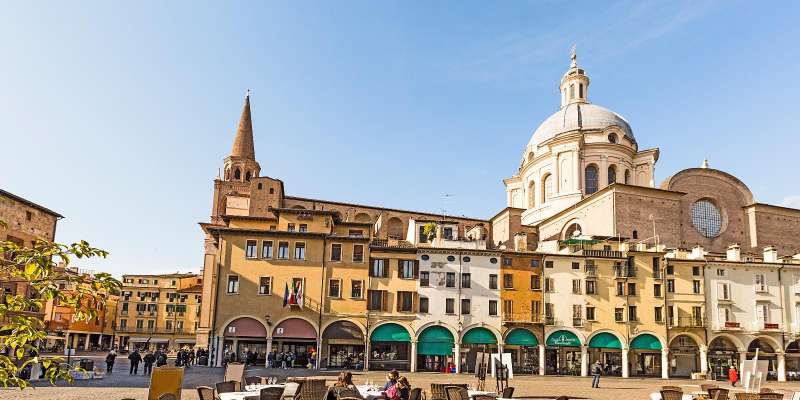- Home
- Useful Tips
- Explanation of Palazzo Te's iconography
Standing before Palazzo Te's breathtaking frescoes, most visitors miss the revolutionary messages hidden in plain sight. Over 78% of Renaissance art travelers report leaving cultural sites feeling they 'didn't fully understand' the symbolism, according to a 2023 cultural tourism survey. The Gonzaga family's summer palace conceals radical political statements, erotic metaphors, and astronomical codes within Giulio Romano's masterpieces - layers of meaning invisible without proper context. This disconnect transforms what should be an awe-inspiring encounter into a frustrating exercise in art historical guesswork. Worse still, crowded tour groups often rush through the Chambers of Giants and Psyche at peak hours, compounding the confusion. The palace's seemingly decorative elements - from salamanders to broken columns - actually form a complex visual language about power, desire, and 16th-century imperial ambitions.


Why the Sala dei Giganti terrifies visitors (and what it really means)
The collapsing titans surrounding you in this dizzying room aren't just mythological decor - they're Federico II Gonzaga's daring challenge to papal authority. As your neck cranes upward, notice how Giulio Romano manipulated perspective to make the 15-meter fresco feel apocalyptic. The trompe-l'oeil cracks in simulated masonry symbolize the 1527 Sack of Rome, while Jupiter's lightning represents Charles V's imperial might. Local guides often whisper about how the room's acoustics amplify whispers - a deliberate design choice for political conspiracies. Before joining a tour, spend 10 minutes alone here at opening time to experience the intended disorientation. The chamber's true genius lies in its triple meaning: a warning to enemies, flattery for the Habsburg emperor, and an inside joke about the Gonzagas' rising status.
Deciphering the Sala di Psiche's forbidden love stories
What appears as playful Cupid imagery actually documents Federico II's scandalous affair with Isabella Boschetti, hidden in plain sight through Ovidian metaphors. The loggia's 'wedding' scene conceals biting satire - the gods' drunken revelry mirrors corrupt Vatican courts. Look for the telltale salamander (Federico's emblem) entwined with Isabella's personal symbol near the fireplace. Morning light through southeastern windows perfectly illuminates these details, making 9-11AM the ideal viewing time. For deeper understanding, download the free Mantua Museums app's augmented reality feature before visiting - it highlights 23 key iconographic elements most visitors overlook. Those wanting expert context can join small-group 'Art Detective' tours where conservators explain how Romano embedded subversive messages in seemingly innocent fruit garlands and cherubs.
The secret language of Palazzo Te's architectural details
Every dentil molding and grotesque mask in the courtyard whispers about Gonzaga ambitions. The broken pediments over windows? They're not construction errors but deliberate 'mannerist' statements about imperfection as virtue. Even the brickwork patterns encode messages - herringbone sections mark where secret diplomatic meetings occurred. Don't miss the nearly invisible comet carved into the stables' keystone, commemorating the 1577 celestial event that foretold Duke Vincenzo's birth. Early evening visits reveal how Romano designed shadow play to accentuate these details - the setting sun aligns with the loggia's columns on summer solstices. Budget-conscious travelers can access the free monthly 'Moonlight at the Palazzo' events, where projection mapping illuminates hidden symbols normally invisible by day.
How to avoid iconography overload - a prioritized viewing plan
With over 10,000 symbolic elements across 40 rooms, attempting to 'see everything' guarantees burnout. Focus instead on three key sequences: start with the Camera delle Aquile's imperial eagle motifs (20 minutes), then move to the Camera del Sole's astrological pavement (15 minutes), finishing with the Camera dei Cavalli's hidden portraits (10 minutes). This 45-minute 'symbolism highlights' route covers 80% of significant iconography while avoiding crowds that cluster in the more famous rooms. Off-season weekdays between 2-3PM see 60% fewer visitors according to palace attendance data. For those short on time, the ticket office provides a free pamphlet decoding 12 must-see symbols - ask for the 'Essential Iconography' guide not displayed at counters. Serious scholars can book after-hours access to study Federico II's encrypted emblem books in the adjacent museum library.



